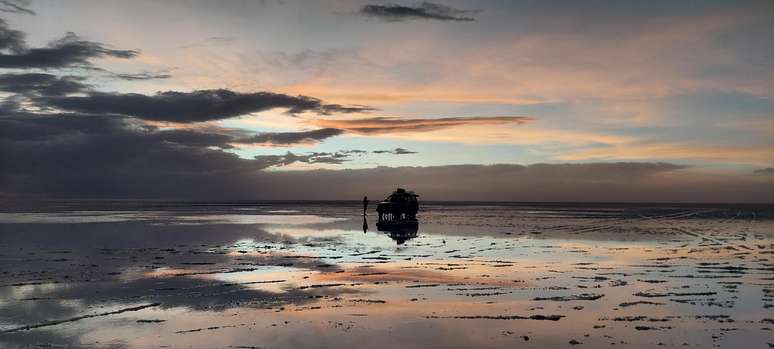At almost 11 thousand square kilometers, the place is the largest and highest salt desert in the world. Understand how the visit works
OR Uyuni Salt Flats, located in southwestern Bolivia, is the largest salt flat in the world. Formed by prehistoric lakes that dried up, leaving behind a crust of salt, the place is so vast that it is visible from space and has gained fame in recent years thanks to the highly Instagrammable landscapes that its reflections produce.
The famous images occur during the rainy season: the Salar is covered in a thin layer of water, creating a perfect mirror that reflects the sky, making it a popular tourist destination for photographers. In addition to the surreal aspect, the Salar de Uyuni It is also known for being home to pink flamingos and for its unique geological formations, such as giant cactus islands.
In addition to its tourist attraction, the region has also become economically desirable in recent times because it hosts the largest known reserves of lithium in the world, a key component for the production of batteries for electric vehicles and antidepressant drugs.
What to organize before the trip?
Tourist agencies: In Uyuni, several agencies offer tourist packages to explore the salt pan and its surroundings, not all of which are of good quality. Choosing a reliable agency is essential to guarantee a safe and satisfying trip. Due to the complicated access to the salt flat and the lack of infrastructure along the route, it is not advisable to make this trip alone. Do a good search online and read reviews from other travelers to make sure you find a reliable agency.
+ Civitatis organizes excursions lasting 1 to 4 days through the Salar do Uyuni
Tours: Being a tourist spot, there are many places to explore in this area. A day trip can take you to major stops like the train graveyard and Incahuasi Island (or Pescado Island). Being an island covered in giant cacti, the place testifies that, all around, the landscape was once covered in water with active volcanoes. A longer trip can offer a more complete experience, including amazement Salar de Coipasathe altiplanic lagoons, the geysers and even the border with Chile and the Licancabur Volcano.
Accommodations: There are options ranging from iconic salt hotels, where rooms are covered in salt bricks, to traditional accommodation, such as inns and guesthouses around the Salar. Rooms are generally simple, so it’s a good idea to be prepared, and they usually include home-cooked meals. For the more adventurous, some agencies offer packages that include overnight stays in tents during excursions: it is best to pay attention to the temperature, given that the altitude of 3,600 meters guarantees cold nights at any time of the year. Additionally, there are stays in nearby villages, ranging from family guesthouses to small hotels. Whatever your choice, it is important to book in advance, especially during high season when demand tends to be higher.
Guided tours can last hours or days
Most visits to the Salar de Uyuni and the surrounding area are covered by guided tours offered by local agencies. Advised by the vastness and remote nature of the salt pan, the guides have in-depth knowledge of the area, ensuring safety and access to special places.
Additionally, tours generally include transportation, accommodations, meals, and planned activities, making travel more affordable. They provide an interpretation of local culture, history and ecology, enriching the experience of visitors, who can interact with other travellers.
There are tours for different tastes and budgets. It is possible to take a short trip of just six hours for around R$300 per person, but many of the famous sights are not accessible with such short trips. The most popular tours, which include overnight accommodation, generally last two or three days and usually cost less than R$1,200 per traveler.
+ Civitatis organizes excursions lasting 1 to 4 days through the Salar do Uyuni
What is the best time to visit?
The best time depends on your preferences and travel goals. During the dry season (May to October), the stable climate – sunny days and cool nights – and the absence of rain create ideal conditions for visiting the Salar. During this time the place is quite crowded.
The rainy season (November to April) offers the famous photos of the salt mirrors, but some roads may be impassable due to mud. This less crowded season, however, can offer a quieter experience for those who prefer to avoid the crowds.
Whatever the choice, it is important to pay close attention, especially when traveling along the Salar, where optical illusions can be deceiving. Sunscreen, sunglasses, water, comfortable shoes and clothing to protect yourself from the cold and wind are essential!
Where to start from
A trip to Salar do Uyuni can begin Peace, as you can see in this reportage, or even through the Atacama desert for those in Chile.
Source: Terra
Ben Stock is a lifestyle journalist and author at Gossipify. He writes about topics such as health, wellness, travel, food and home decor. He provides practical advice and inspiration to improve well-being, keeps readers up to date with latest lifestyle news and trends, known for his engaging writing style, in-depth analysis and unique perspectives.






